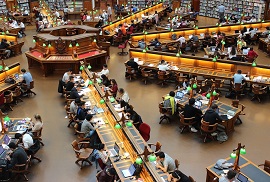
The funding of higher studies is handled by the States, by students or by private entities. The percentages of each part vary greatly among the different countries of the OECD. Public investment is decisive to ensure equal opportunities and the access to higher education for all citizens.
20 june 2016
Students that get to graduate in higher studies can access the labour market more easily than those who do not reach that level of studies. Also, incomes are higher for those that hold a university qualification.
Among the countries of the Organisation for Economic Co-operation and Development (OECD) there are substantial differences in the way of approaching the economic policies in this field. In some member states the State is the main funding source; however, in others, the families outlay a higher cost or it comes from private entities.
The public spending in higher education averages 70 % among the OECD countries
A recent report carried out by the OECD analyses the funding of higher education of this organisation’s member states. The study focuses on the role of public institutions and on the existing differences between the different countries of the OECD, with tendencies and established models that present important similarities.
A 70 % average of the funding of higher studies is the responsibility of the states, according to the valuation of data of the OECD member countries that have been analysed. Another 20 % of the outlay is carried out by the families and the remaining 10 % comes from the private field. In Spain, the public investment reaches a bit more of 70 %, while private aids only cover the 5 %.
Equal Opportunities
The access to university can be limited by the high cost of these studies. In these cases, economic inequality can determine who can afford accessing higher studies, so one of the objectives of the States is trying to reduce inequality and trying to make higher education more accessible.
Public economic aids addressed to students can serve as a tool to resolve the problem of the high access fees. In countries as Australia and New Zealand, university tuitions register numbers above average despite their high cost, since they have a developed system of financial aid. Still, the report also indicates that the fact that prices are so high can suppose that who cannot afford to pay this cost do not try to access university although there are public aids programmes.
Public aids can foster equal opportunities and reduce economic inequalities that condition the access to higher studies
According to the report, where the spending of families is high it is also observed a funding increase by private institutions, firms or alike. This way, in those places where public aids have less importance, private spending is higher to cover a part of the financial vacuum that students have to assume.
Nordic system
In countries where higher education is free, public funding also represents a very important role although it does not serve to promote equal opportunities to access. In Finland, around 50 % of students receive some kind of grant, loan or aid during their academic years. This is an example that shows that public economics have a very significant power in the economic development of the country.
To carry out these economic policies in the places where accessing university is free, as in Slovakia, Estonia or Slovenia, the income taxes of citizens are higher. This way, one of the main pillars to get the sustainability of this system is the same society that provides the needed funds with more progressive tax collection models.
Published by: David Gil Garcia












